Do you have a question about the La Crosse Technology 328-10618 and is the answer not in the manual?
Introduces the Wi-Fi Professional Weather Station and its purpose, along with model details.
Instructions for installing batteries in various sensors and the main station, including power cord connection.
Critical warnings and precautions regarding button cell battery ingestion, emphasizing immediate medical attention.
Guidance for mounting wind, rain, and thermo-hygro sensors to ensure accurate readings and performance.
Describes the functions of buttons located on the station's top and side panels for various operations.
Explains icons for battery status, sensor reception, and temperature trends displayed on the station.
Details icons for units (MPH/KMH, IN/MM), precipitation, and weather forecast symbols.
Details mobile device needs, network connection, and instructions for downloading and launching the La Crosse View app.
Explains icons specific to displaying additional sensor data in the Extra Sensor area of the station.
Lists features available via the app like advanced forecasts, HI/LO records, and chance of precipitation.
Highlights features like data streaming, remote monitoring, alerts, and graph viewing enabled by app connectivity.
Explains advanced forecast icons and precipitation percentages for various weather conditions like sunny, rain, and snow.
Instructions for accessing and interpreting 7-day daily forecasts, including forecast icons and HI/LO temperatures.
Instructions for accessing and interpreting 12-hour hourly forecasts, including weather icons and wind direction.
How AccuWeather Hi/Lo temperatures and wind direction are displayed on the station when connected.
Steps to select and display up to 3 custom data items on the station via the La Crosse View app.
List of available data points like wind speed, UV index, and dew point for in-home display customization.
Step-by-step guide for integrating additional sensors via the La Crosse View app, including scanning device IDs.
Explains station status messages like 'All OK Connected', 'Check App', and 'Lost Wifi' related to connectivity.
Addresses 'No Weather Service' status, its meaning, and expected resolution by the weather server.
How to change the display brightness to 5 different levels, including turning it off.
Instructions for setting automatic dimming times for the backlight to adjust brightness for sleeping.
Guide to entering the settings menu and adjusting flashing values using the buttons.
Lists the configurable options like time format, beep settings, hour, minutes, year, month, date, and temperature units.
How to view data from optional sensors like pressure, temperature/humidity, and contact probes.
Step-by-step process to add additional sensors like Thermo-Hygro, Wind Speed, or Water Leak to the station.
Detailed steps for adding sensors, including pressing the TX button and scanning the barcode ID.
Instructions on how to delete sensors from the station by holding the MINUS button.
How to view real-time current wind speed and historical peak wind speeds (Top Speed) for different periods.
Explains how to access and interpret various historical wind speed records: 1-hour, 24-hour, 7-day, monthly, and yearly.
Explains current rainfall ('NOW'), 1-hour, 24-hour, 7-day, and monthly rainfall data tracking.
How to view historical high and low temperature and humidity data with timestamps of occurrence.
Procedure for clearing recorded temperature and humidity extremes and resetting them to current values.
Explains how heat index and wind chill affect perceived temperature based on outdoor conditions.
Interpreting the arrows indicating temperature changes over the past hour.
Details on the station's pressure sensor, units (InHg/hPa), and pressure tendency indicators.
How to interpret the sensor connection status indicators (solid, flashing, or no indicator).
Steps to find sensor IDs and initiate a search for connected sensors on the station.
Instructions for removing sensors from the station's memory, including automatic replacement search.
How to identify and address low battery warnings for various components of the weather station.
Steps to reset the station to its original default settings, including Wi-Fi and sensor IDs.
Step-by-step guide for installing the LTV-W1 or LTV-W2 Wind Speed Sensor, including battery insertion.
Recommendations for optimal placement of the wind sensor for accurate wind speed readings.
Step-by-step guide for installing the LTV-R3 Rain Sensor, including battery installation and funnel setup.
Guidance on mounting the rain sensor for accurate rain count and ensuring proper water drainage.
Step-by-step guide for installing the LTV-TH2 Thermo-Hygro Sensor, including battery and mounting.
Instructions for connecting the main V30v2 station's power and mounting it near a Wi-Fi router.
Battery installation and basic settings configuration for the LTV-D1 Bonus Station.
How to switch between and view indoor and outdoor temperature/humidity readings on the bonus station.
Steps to take if the bonus station loses connection to the Thermo-Hygro sensor, including searching and restarting.
Information on how to contact customer support via phone or online form for assistance.
Details on temperature, humidity, pressure, wind speed, and rainfall ranges for all components.
Information on power cords, Wi-Fi transmission frequency, and expected battery life for all devices.
Physical dimensions of station components and sensor data update frequencies.
Guidelines for product care, battery handling, and details on the 1-year limited warranty.
Details on FCC rules, interference, radiation exposure limits, and user compliance requirements.
Information regarding Industry Canada's license-exempt RSS standards and device operation.
Introduces the Wi-Fi Professional Weather Station and its purpose, along with model details.
Instructions for installing batteries in various sensors and the main station, including power cord connection.
Critical warnings and precautions regarding button cell battery ingestion, emphasizing immediate medical attention.
Guidance for mounting wind, rain, and thermo-hygro sensors to ensure accurate readings and performance.
Describes the functions of buttons located on the station's top and side panels for various operations.
Explains icons for battery status, sensor reception, and temperature trends displayed on the station.
Details icons for units (MPH/KMH, IN/MM), precipitation, and weather forecast symbols.
Details mobile device needs, network connection, and instructions for downloading and launching the La Crosse View app.
Explains icons specific to displaying additional sensor data in the Extra Sensor area of the station.
Lists features available via the app like advanced forecasts, HI/LO records, and chance of precipitation.
Highlights features like data streaming, remote monitoring, alerts, and graph viewing enabled by app connectivity.
Explains advanced forecast icons and precipitation percentages for various weather conditions like sunny, rain, and snow.
Instructions for accessing and interpreting 7-day daily forecasts, including forecast icons and HI/LO temperatures.
Instructions for accessing and interpreting 12-hour hourly forecasts, including weather icons and wind direction.
How AccuWeather Hi/Lo temperatures and wind direction are displayed on the station when connected.
Steps to select and display up to 3 custom data items on the station via the La Crosse View app.
List of available data points like wind speed, UV index, and dew point for in-home display customization.
Step-by-step guide for integrating additional sensors via the La Crosse View app, including scanning device IDs.
Explains station status messages like 'All OK Connected', 'Check App', and 'Lost Wifi' related to connectivity.
Addresses 'No Weather Service' status, its meaning, and expected resolution by the weather server.
How to change the display brightness to 5 different levels, including turning it off.
Instructions for setting automatic dimming times for the backlight to adjust brightness for sleeping.
Guide to entering the settings menu and adjusting flashing values using the buttons.
Lists the configurable options like time format, beep settings, hour, minutes, year, month, date, and temperature units.
How to view data from optional sensors like pressure, temperature/humidity, and contact probes.
Step-by-step process to add additional sensors like Thermo-Hygro, Wind Speed, or Water Leak to the station.
Detailed steps for adding sensors, including pressing the TX button and scanning the barcode ID.
Instructions on how to delete sensors from the station by holding the MINUS button.
How to view real-time current wind speed and historical peak wind speeds (Top Speed) for different periods.
Explains how to access and interpret various historical wind speed records: 1-hour, 24-hour, 7-day, monthly, and yearly.
Explains current rainfall ('NOW'), 1-hour, 24-hour, 7-day, and monthly rainfall data tracking.
How to view historical high and low temperature and humidity data with timestamps of occurrence.
Procedure for clearing recorded temperature and humidity extremes and resetting them to current values.
Explains how heat index and wind chill affect perceived temperature based on outdoor conditions.
Interpreting the arrows indicating temperature changes over the past hour.
Details on the station's pressure sensor, units (InHg/hPa), and pressure tendency indicators.
How to interpret the sensor connection status indicators (solid, flashing, or no indicator).
Steps to find sensor IDs and initiate a search for connected sensors on the station.
Instructions for removing sensors from the station's memory, including automatic replacement search.
How to identify and address low battery warnings for various components of the weather station.
Steps to reset the station to its original default settings, including Wi-Fi and sensor IDs.
Step-by-step guide for installing the LTV-W1 or LTV-W2 Wind Speed Sensor, including battery insertion.
Recommendations for optimal placement of the wind sensor for accurate wind speed readings.
Step-by-step guide for installing the LTV-R3 Rain Sensor, including battery installation and funnel setup.
Guidance on mounting the rain sensor for accurate rain count and ensuring proper water drainage.
Step-by-step guide for installing the LTV-TH2 Thermo-Hygro Sensor, including battery and mounting.
Instructions for connecting the main V30v2 station's power and mounting it near a Wi-Fi router.
Battery installation and basic settings configuration for the LTV-D1 Bonus Station.
How to switch between and view indoor and outdoor temperature/humidity readings on the bonus station.
Steps to take if the bonus station loses connection to the Thermo-Hygro sensor, including searching and restarting.
Information on how to contact customer support via phone or online form for assistance.
Details on temperature, humidity, pressure, wind speed, and rainfall ranges for all components.
Information on power cords, Wi-Fi transmission frequency, and expected battery life for all devices.
Physical dimensions of station components and sensor data update frequencies.
Guidelines for product care, battery handling, and details on the 1-year limited warranty.
Details on FCC rules, interference, radiation exposure limits, and user compliance requirements.
Information regarding Industry Canada's license-exempt RSS standards and device operation.
| Display Type | LCD |
|---|---|
| Power Requirements (Sensor) | 2 x AA batteries (not included) |
| Wireless Transmission Frequency | 433 MHz |
| Temperature Range | -40°F to 140°F (-40°C to 60°C) |
| Humidity Range | 10% to 99% RH |
| Time Display | 12/24 hour |
| Indoor Temperature Range | 14.2°F to 139.8°F (-9.9°C to 59.9°C) |
| Wireless Range | 330 feet (100 meters) in open air |

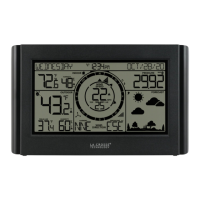


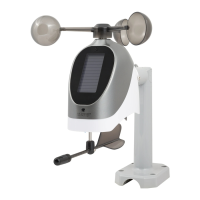
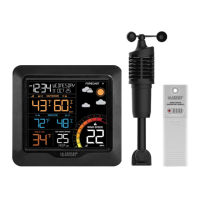
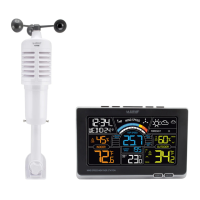
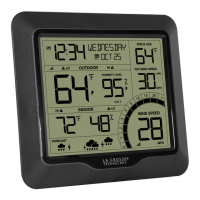

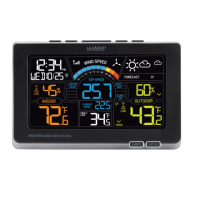
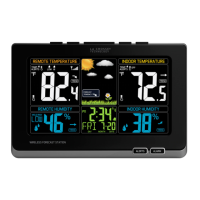
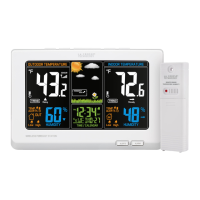
